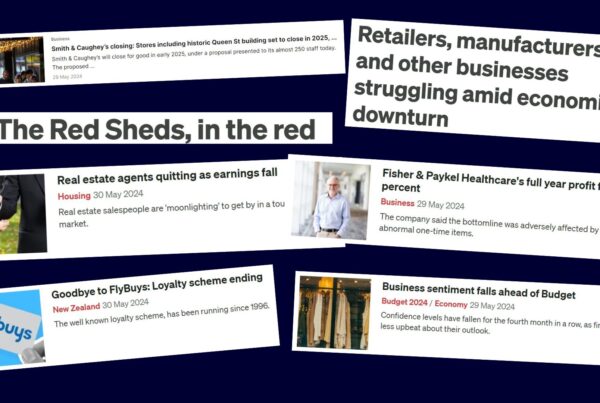
DISCLAIMER: Every business is different. The information provided in this blog post is for general informational purposes only. If you want specific advice for your business, visit our Work With Us page to get tailored business support.
Right now there are a lot of businesses cutting costs in a major way. We are in tougher economic times and cutting costs is a great way to help your business survive.
However, like anything we do in business, we don’t want to make erratic decisions. This is true with cost-cutting decisions as well. Not all cost-cutting is a good idea. In fact, it could lead your business into a very fast decline!
That is what I am seeing with many businesses right now. They are cutting costs without thinking about the true impact it will have on the business. They are making decisions that will significantly decline the business in the short or long term without realising it.
When cutting costs during tough economic times, there are several important factors to consider, ensuring that the cost reductions are effective and sustainable over both the short and long term.
There are 4 particular areas I see businesses cut costs in without fully understanding the impact that it will have on their business.
Cutting costs in tough times in these 4 key areas? Here’s what you need to know:
While it may be tempting to cut marketing and advertising expenses during tough times, reducing your visibility can harm your brand and client acquisition efforts. Marketing is meant to get you clients and bring in revenue. Cutting costs here can send your business into a quick decline when it doesn’t have to.
Yes, it can be that your marketing efforts aren’t getting the same results as they used to. Your marketing will likely need to be adjusted during tougher times because it can take longer to get clients. This is where you need to adjust, develop, and optimise your marketing strategies instead of cutting them. The smartest thing you can do with your marketing is make sure it is being tracked and measured so you have a good idea of what is working and what is not. This will allow you to make smarter choices when cutting costs in this area.
Also, maintaining a presence in the market can help you retain existing clients. This means you will have less of a drop off in revenue from current clients leaving.
-
Coaching and Support
During tough times we often need more help, not less. While it can be easy to feel that the business is going backwards so you can’t afford a business coach or extra external support, it might be that the support is exactly what you need. To help you see things differently, help you through the hardship emotionally and give you strategies that will keep your business afloat.
Tough times can push us to our limits. It is hard as a business owner to hold the weight and responsibility of everything that is going on. So, it is important that we don’t do it alone. A business coach is there to support you and your business. They can be invaluable in helping you navigate the tough times with more ease and less stress. Plus, they can keep you motivated and focused on the important stuff, moving your business forward, instead of backwards.
They are there to help you succeed, so let them do that instead of cutting them out. And if you don’t already have a business coach, now is a great time to hire one.
-
Impactful employees
It is brutally hard when you need to cut staff members. Afterall these are people with financial needs themselves and some have families to look after. However sometimes hard decisions do need to be made, and during tougher economic times you may find that you need to let some staff go. If this happens, it is crucial that you pull yourself out of the emotion of the situation to help make the decision.
Too often a business owner will keep one staff member over another because of emotions rather than the better choice for the business. Look at who is having the biggest impact on the business. Who is bringing in the revenue? Who is helping the clients stay for longer or buy more? Are they a key player in the business and will the void they leave help the business to move forward, or send it massively backwards?
Look at who is performing rather than who you like the most. If your business is going to make it through the tough times, then really hard decisions need to be made. You can still have tough conversations with staff in a kind and empathetic way, but ultimately if you are cutting staff then it does need to be done strategically.
-
Customer Service and retention
One thing a lot of businesses forget is that it is easier to keep clients, rather than having to find new ones. The cost of obtaining new clients can be significant and adds up. During tough economic times, your clients will also be looking at cutting their own costs. So now is the time to focus on customer service and retention, not to cut your costs here!
During tougher times people use any excuse to jump ship, so if your customer service is slipping then that could be the very reason that they use to make the jump and stop buying off you.
Shine the spotlight on your customer service and retention right now with your team. How can you make it better in a cost-effective way?

The specific costs to preserve will depend on your industry, business model, and individual circumstances. It’s crucial to assess each cost item carefully and consider its impact on your business’s ability to weather these tougher economic times, while still positioning yourself for future growth.
Here are some questions to ask before cutting a particular cost in your business:
- Is this cost bringing in money to the business?
- Is this cost essential for the business to run?
- Will cutting this cost compromise our core operations?
- Will cutting this cost compromise the growth of our business?
- Are there other more cost-effective options that we could use instead of cutting this entirely?
- What are the potential short-term and long-term consequences of cutting these costs?
- What are the potential implications of cost-cutting on staff morale and productivity?
Asking these questions will help you to make more strategic decisions when it comes to cost cutting. If you can see that there will be a negative impact on the business, it doesn’t mean that you shouldn’t cut that cost, but at least you will have a better understanding of the impact it will have, so you can make a plan to lessen the impact.
Where should you cut costs?
So far I have shared some areas that you need to be cautious with when cutting costs. That doesn’t necessarily help you to get your running costs down. So here are 10 practical tips to help you cut costs effectively and sustainably:
- Firstly, go through your bank statements and see what your outgoings are. If you don’t do this regularly, then you may get quite a surprise about where the money is going! Cancel any services or subscriptions that you are no longer using. This is an easy first place to start cutting costs.
- Make decisions about other costs that are ‘nice to have.’ You could cancel these or pause them if that is an option for a few months to see if you can get the business back on track again. There are usually significant ‘nice to have’ costs within businesses. Yes, we would really like to keep them, but if getting rid of them for a short time is not going to affect the business and means that the business is more likely to survive, then get rid of them and keep moving on.
- Are there free or lower cost alternatives that are now available with some of your costs? The market is changing all the time, so if you signed up to a service years ago, there is likely many better options out there that you could change to. You do need to take into consideration the switch over time, money and energy before you make decisions here.
- Can you get a temporary rent reduction on your premises? Ask the landlord if there are any options to reduce your rent for a fixed amount of time to help out. Some landlords will be accommodating as it is better for them to take less on than having an empty space during a recession.
- Or if it works for your particular business, you could move all your staff to working remotely, saving on a business premises altogether.
- Let go of employees and contractors that are no longer essential to the business
- Cut out marketing costs that are not producing a result for your business – make sure you base this on stats, rather than assumptions
- Look for inefficiencies in the business and see how these can be fixed up so they are costing you less or making you more
- Switch travelling costs to online meetings if you can. Instead of travelling all the time to have meetings, see if you can switch all or some of these to online meetings. Even if for a short time to help reduce the outgoings.
- Get your staff onboard and ask them where they think costs could be cut. They usually have the best experience and exposure to the day to day business and could provide you with valuable insights. This also includes them in solving the problem and getting behind as a team to fix it.
It isn’t easy. Tough decisions do need to be made right now. Just make sure you are being smart about it, instead of burying your head in the sand and hoping it will all work out. Put a strategy in place. Look for inefficiencies, unnecessary expenditures, and opportunities that you can take advantage of to make a difference to your bottom line.
Final Cost Cutting Tip
While focusing on cost-cutting, don’t lose sight of the future. Don’t let your goals and dreams for the business die. Lots of businesses do grow during tougher times, but if your business is one that has gone backwards, you don’t need to give up entirely.
 Remember that these tough economic times will pass. Cycles come and go. Develop strategies and plans for how you will position your business to recover and thrive. It is wise to be working smarter right now. It can take much more effort to get the same results that you were getting a few years ago. Be strategic and be open to the possibility that things can be better.
Remember that these tough economic times will pass. Cycles come and go. Develop strategies and plans for how you will position your business to recover and thrive. It is wise to be working smarter right now. It can take much more effort to get the same results that you were getting a few years ago. Be strategic and be open to the possibility that things can be better.
If you want tailored help to make a strategic plan to move your business forward right now then check out our Business Coaching options here.
I would love to help you succeed!






